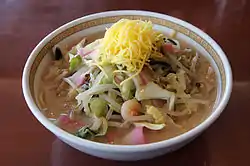ちゃんぽん
Japanese
Etymology
Probably borrowed from some variant of Chinese 攙和/搀和 (“to mix”).[1][2][3] Compare modern Min Nan reading chham-hô, Mandarin chānhuò.
The initial sense was mixed together, appearing in texts from the mid-1700s.[1]
The “noodle dish” sense is traced to a food item on offer at the 四海樓 (Shikairo, literally “Four-Seas House”) Chinese restaurant founded in Nagasaki in 1899.[4][5][6][7] Compare English hodgepodge in reference to a mixed-together food item.
Superficially similar, but probably not directly related, to チャンプルー (chanpurū, “Okinawan stir-fry”).
Descendants
References
- 1988, 国語大辞典(新装版) (Kokugo Dai Jiten, Revised Edition) (in Japanese), Tōkyō: Shogakukan
- 1995, 大辞泉 (Daijisen) (in Japanese), Tōkyō: Shogakukan, →ISBN
- 1997, 新明解国語辞典 (Shin Meikai Kokugo Jiten), Fifth Edition (in Japanese), Tōkyō: Sanseidō, →ISBN
- Entry in the 和・洋・中・エスニック 世界の料理がわかる辞典 (Wa-Yō-Chū-Esunikku Sekai no Ryōri ga Wakaru Jiten, “Japanese-Western-Chinese-Ethnic: Dictionary for Understanding World Cooking”, in Japanese)]
- “ちゃんぽん”, in 世界大百科事典 第2版 (Sekai Dai-hyakka Jiten Dainihan, “Heibonsha World Encyclopedia Second Edition”) (in Japanese), Tōkyō: Heibonsha, 1998
- Entry in the 日本の郷土料理がわかる辞典 (Nihon no Kyōdo Ryōri ga Wakaru Jiten, “Dictionary for Understanding Japanese Home-town Cooking”, in Japanese)
- “ちゃんぽん”, in 日本大百科全書:ニッポニカ (Nippon Dai Hyakka Zensho: Nipponica, “Encyclopedia Nipponica”) (in Japanese), Tōkyō: Shogakukan, 1984
- 2006, 大辞林 (Daijirin), Third Edition (in Japanese), Tōkyō: Sanseidō, →ISBN
- 1998, NHK日本語発音アクセント辞典 (NHK Japanese Pronunciation Accent Dictionary) (in Japanese), Tōkyō: NHK, →ISBN
This article is issued from Wiktionary. The text is licensed under Creative Commons - Attribution - Sharealike. Additional terms may apply for the media files.
